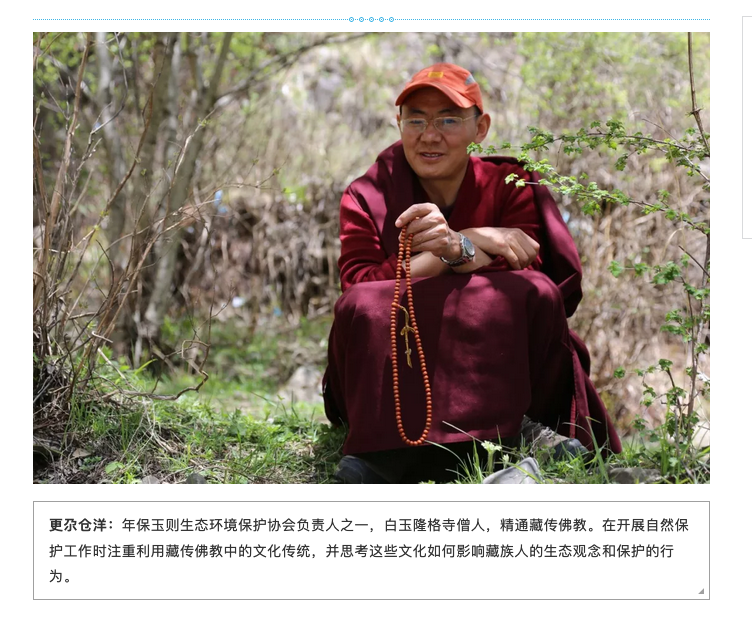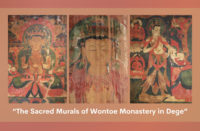
High Peaks Pure Earth presents an article about Tibetans and the environment, originally published in Chinese by the TibetSheep WeChat channel on October 1, 2018. The article is the seventh in a series of write ups from a group calling themselves the “Social and Natural Resources Study Group”.
The article makes for an interesting read especially coming after Professor Thubten Phuntsok’s recent piece “Superstition Is The Cause Of Environmental Destruction”. This article describes the Labrang Monastery monk and environmentalist Kunga Tsayang’s outlook and views on Tibetans, Buddhism and the environment.
Readers may remember Kunga Tsayang (pen name Gangnyi) from his essay “Who Are the Real Separatists”. In March 2009 he was arrested and held until November when he was sentenced to five years in prison by Kanlho Intermediate People’s Court for “disclosing state secrets.” He was released in January 2014.
“Without Outside Influences, We Would Not Need to Protect the Environment”
Tibet Sheep
October 1, 2018
When the 2018 Social and Natural Resources Study Group was coming to an end, we started to shift the focus of the discussion from nature to society and then to a profound discussion on culture. Culture can be seen as a way of looking at the world that a group of people has acquired; different systems of values and different worldviews influence the process of social interaction and decision-making strategies. The ways in which a society looks upon the relationship between man and nature reflects that society’s way of using natural resources as well as how it executes the conservation of nature.
For the sharing session of our study group, we invited Kunga Tsayang, one of the persons in charge of Nyanpo Yutse Conservation Association, an organisation for environmental protection from Sanjiangyuan National Nature Reserve co-managed by monks and herdsmen. He shared his understanding of cultural and natural protection in Tibetan traditions.
Below is the content that Kunga Tsayang shared with our study group.

The Environment in Tibetan Culture
In Tibetan culture, we believe that the environment of the earth is the homeland of all living things. In Buddhism, the idea of “all living things” refers to animals with a life and a soul, including insects, birds etc. The earth is a common place for all living things. Among them, human beings are particularly strong, or maybe we should say bad, animals. From the perspective of environmental destruction, human beings are the most important animal.
In this common place, all living beings, including humans, only have rights to use but no rights to destroy. If we break a pair of chopsticks, a bowl or a teacup how will the people coming after us eat or drink? This is what we should think about. According to Buddhism, all life is equal. We need to think about other people and animals as ourselves and reflect on how we would feel if our own homeland was to be destroyed.

The Heart of Recognising your Mother
Buddhism often refers to the Seven Point Training in Cause and Effect (recognising beings as our past mothers, remembering the kindness of beings, a sense of gratitude for the kindness love, wishing beings have happiness, compassion, responsibility and bodhichitta). This is, I believe, a very important idea. The first one is “recognising beings as our past mothers”. But it does not simply refer to one’s current mother.
Buddhist texts say: where did previous incarnations come from? When did it all start? No one has an answer. Every single animal may well be our previous incarnation or the incarnation of the incarnation or the mother of the incarnation of over one hundred years ago. When they were our mother, they loved us and nurtured us just as our mother does today. When we really “recognise our mother” in this way, we understand that we need to protect all those lives. Hence, Tibetans do not only protect animals to protect people, they do so to protect all living things.

“Conservation” according to Tibetan understanding and outside influence
We can say that the concept of “protection” has always existed in Tibetan thought. Without outside influences, Tibetan areas would not need an environmental protection group or even externally introduced ideas such as “environmental protection” at all. People living on the Tibetan plateau have been protecting the environment for generations.
Traditional Tibetan lifestyles are particularly “environmentally friendly.” This is because food items, drinks, tents (like the ones made from black yak hide) or houses (mainly built using stones and mud, which, once no longer needed, degrade and return to nature) all come from nature. Hence, I believe that Tibetan people and the natural environment have always formed one integral whole.

External concepts such as “protecting animals” or “flagship species” need to be integrated into the local culture to be better understood and applied. For example, the snow leopard, as an animal under national protection, is very important. But according to Tibetan culture, all living things are equal, so many people don’t understand why we need to protect the snow leopard, but not other animals. So when we explain these kinds of external concepts, we highlight that the snow leopard is a nationally protected animal and that there exists a legal basis for the protection of such flagship species, which gives the matter a great deal of support. Also, by protecting the snow leopard, we also protect its natural habitat and thus also other animals and plants that are home to this area.
Paying attention to how we exploit and use natural resources
Tibetans harvest medicinal ingredients, but not randomly, there are established standards. For example, if one year people harvest in one mountain valley, they will not choose the same one again in the following years. We understand that medicinal ingredients need a long time to grow again.
At the same time, Tibetans also pay a lot of attention to mining. For example, whenever some influential locals or outsiders wanted to open a mine in an area, they would face up to strong opposition from local residents and monasteries. It is still like that today. Traditionally, many locals did not see the need for too much development. We have enough to eat, we have clothes to wear, that’s enough.

The earth is not only our mother, it is also our child
If we want to protect the environment, we need to first know this earth, need to understand the relationship between the earth and human beings. On Earth Day in 2018, Barang, who is in charge of controlling the siltation of the grasslands in his hometown in Dzoege County, organised a painting event. My younger brother Tseten Nyima contributed a painting showing a pregnant mother nurturing the earth.
When talking about protecting the earth’s environment, many people often refer to the earth metaphorically as our mother. But my younger brother turned this around and painted the earth as a child. Times are changing, nowadays many children are no longer showing the same filial piety to their parents; but there are no parents in this world who do not dearly love their children. So, I really think that this is an excellent example.

Nyanpo Yutse Conservation Association was established precisely because, due to historical reasons and the impact of outside influences today, many people (especially young people) have lost the original traditional ideas, making environmental protection a cause to be re-established.

We have to reconstruct the traditional ideas of cause and effect that are inherent in protection. For this reason, our association entertains the following concept of protection: when you understand nature, you will like and protect nature.





Follow Us!